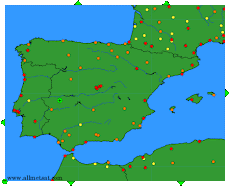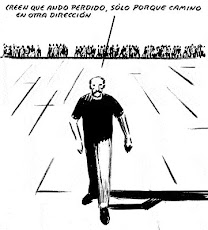viernes, 6 de julio de 2012
INFORME FINAL DEL ACCIDENTE DEL VUELO AF447 RÍO DE JANEIRO - PARÍS
La BEA (Bureau d'Enquêtes et d'Analyses pour la sécurité de l'aviation civile), la autoridad francesa responsable de las investigaciones de los accidentes e incidentes de aviación civil, ha publicado el informe final del accidente del vuelo AF447, que cubría el trayecto con origen Río de Janeiro y destino París, y que ocurrió sobre el océano Atlántico el día 1 de junio de 2009.
Adjuntamos los enlaces de los artículos publicados en Las mentiras de Barajas sobre este accidente:
• TRAGEDIA AÉREA EN EL ATLÁNTICO
• TRAGEDIA AÉREA EN EL ATLÁNTICO: ANÁLISIS METEOROLÓGICO
• ALGO DE LUZ SOBRE LA TRAGEDIA AÉREA EN EL ATLÁNTICO
• INFORME PRELIMINAR DE LA BEA SOBRE LA TRAGEDIA AÉREA EN EL ATLÁNTICO
• EN ESPAÑOL: INFORME PRELIMINAR DE LA BEA SOBRE LA TRAGEDIA AÉREA EN EL ATLÁNTICO
• ÚLTIMOS DATOS DE LA INVESTIGACIÓN DEL ACCIDENTE DEL AF447
• TERCER INFORME INTERINO DEL ACCIDENTE DEL AF447
En el siguiente enlace se puede acceder a toda la información elaborada por la BEA sobre el accidente del vuelo AF447. Y el enlace del Informe final.
Del informe destacamos la sección 3 en el que se enumeran en detalle las conclusiones de la investigación y las causas del accidente.
3 - CONCLUSION
3.1 Findings
3.2 Causes of the Accident
The obstruction of the Pitot probes by ice crystals during cruise was a phenomenon that was known but misunderstood by the aviation community at the time of the accident. From an operational perspective, the total loss of airspeed information that resulted from this was a failure that was classified in the safety model. After initial reactions that depend upon basic airmanship, it was expected that it would be rapidly diagnosed by pilots and managed where necessary by precautionary measures on the pitch attitude and the thrust, as indicated in the associated procedure.
The occurrence of the failure in the context of flight in cruise completely surprised the pilots of flight AF 447. The apparent difficulties with aeroplane handling at high altitude in turbulence led to excessive handling inputs in roll and a sharp nose-up input by the PF. The destabilisation that resulted from the climbing flight path and the evolution in the pitch attitude and vertical speed was added to the erroneous airspeed indications and ECAM messages, which did not help with the diagnosis. The crew, progressively becoming de-structured, likely never understood that it was faced with a “simple” loss of three sources of airspeed information.
In the minute that followed the autopilot disconnection, the failure of the attempts to understand the situation and the de-structuring of crew cooperation fed on each other until the total loss of cognitive control of the situation. The underlying behavioural hypotheses in classifying the loss of airspeed information as “major” were not validated in the context of this accident. Confirmation of this classification thus supposes additional work on operational feedback that would enable improvements, where required, in crew training, the ergonomics of information supplied to them and the design of procedures.
The aeroplane went into a sustained stall, signalled by the stall warning and strong buffet. Despite these persistent symptoms, the crew never understood that they were stalling and consequently never applied a recovery manoeuvre. The combination of the ergonomics of the warning design, the conditions in which airline pilots are trained and exposed to stalls during their professional training and the process of recurrent training does not generate the expected behaviour in any acceptable reliable way.
In its current form, recognizing the stall warning, even associated with buffet, supposes that the crew accords a minimum level of “legitimacy” to it. This then supposes sufficient previous experience of stalls, a minimum of cognitive availability and understanding of the situation, knowledge of the aeroplane (and its protection modes) and its flight physics. An examination of the current training for airline pilots does not, in general, provide convincing indications of the building and maintenance of the associated skills.
More generally, the double failure of the planned procedural responses shows the limits of the current safety model. When crew action is expected, it is always supposed that they will be capable of initial control of the flight path and of a rapid diagnosis that will allow them to identify the correct entry in the dictionary of procedures. A crew can be faced with an unexpected situation leading to a momentary but profound loss of comprehension. If, in this case, the supposed capacity for initial mastery and then diagnosis is lost, the safety model is then in “common failure mode”. During this event, the initial inability to master the flight path also made it impossible to understand the situation and to access the planned solution.
Thus, the accident resulted from the following succession of events:
• Temporary inconsistency between the airspeed measurements, likely following the obstruction of the Pitot probes by ice crystals that, in particular, caused the autopilot disconnection and the reconfiguration to alternate law;
• Inappropriate control inputs that destabilized the flight path;
• The lack of any link by the crew between the loss of indicated speeds called out and the appropriate procedure;
• The late identification by the PNF of the deviation from the flight path and the insufficient correction applied by the PF;
• The crew not identifying the approach to stall, their lack of immediate response and the exit from the flight envelope;
• The crew’s failure to diagnose the stall situation and consequently a lack of inputs that would have made it possible to recover from it.
These events can be explained by a combination of the following factors:
• The feedback mechanisms on the part of all those involved that made it impossible:
- To identify the repeated non-application of the loss of airspeed information procedure and to remedy this,
- To ensure that the risk model for crews in cruise included icing of the Pitot probes and its consequences;
• The absence of any training, at high altitude, in manual aeroplane handling and in the procedure for ”Vol avec IAS douteuse”;
• Task-sharing that was weakened by:
- Incomprehension of the situation when the autopilot disconnection occurred,
- Poor management of the startle effect that generated a highly charged emotional factor for the two copilots;
• The lack of a clear display in the cockpit of the airspeed inconsistencies identified by the computers;
• The crew not taking into account the stall warning, which could have been due to:
- A failure to identify the aural warning, due to low exposure time in training to stall phenomena, stall warnings and buffet,
- The appearance at the beginning of the event of transient warnings that could be considered as spurious,
- The absence of any visual information to confirm the approach-to-stall after the loss of the limit speeds,
- The possible confusion with an overspeed situation in which buffet is also considered as a symptom,
- Flight Director indications that may led the crew to believe that their actions were appropriate, even though they were not,
- The difficulty in recognizing and understanding the implications of a reconfiguration in alternate law with no angle of attack protection.
Los medios de comunicación, entre los que destacamos Aviación Digital, de la prensa especializada, y El País y El Mundo, de la prensa de información general, se han hecho eco de la publicación del informe.
El avión de Air France se estrelló el 1 de junio de 2009 durante un vuelo nocturno que cubría la ruta de Río de Janeiro a París. No sobrevivió ninguna de las 228 personas que viajaban a bordo.
Tras varias fases de investigación, se logró recuperar cuerpos de las víctimas, buena parte del fuselaje del avión y las cajas negras, que registraron los incidentes de vuelo El avión se estrelló en aguas del Atlántico, a 1.296 kilómetros de la ciudad brasileña de Recife, casi cuatro horas después de haber despegado del aeródromo Galeão con 216 pasajeros a bordo, la mayor parte de ellos franceses y brasileños, y doce miembros de la tripulación.
El informe final atribuye el accidente del vuelo París-Río en 2009 a fallos mecánicos y humanos. En él se emiten 41 recomendaciones de seguridad, entre ellas 25 nuevas respecto a su anterior, y atribuye el accidente a fallos en la ergonomía del avión (un Airbus A330), y a las acciones inapropiadas de los pilotos que estaban sometidos a un fuerte estrés. La tripulación se vio superada por los acontecimientos al romperse el indicador de velocidad de la aeronave, según los investigadores. La investigación sugiere, además, la necesidad de mejoras en la señalización dentro de la cabina de los pilotos.
En la presentación, el director de la BEA recordó que con esta investigación no se buscan responsabilidades sobre el accidente y se remitió a la investigación judicial en marcha, en la que tanto Air France como Airbus fueron procesadas por homicidio involuntario en febrero de 2011, para depurar aquéllas. El informe que será presentado el 10 de julio a los familiares de las víctimas, ha sido filtrado ya, llega a similares conclusiones, aunque suma a los fallos técnicos y humanos la deficiencia de los protocolos seguidos y la meteorología adversa. Entre otros, el estudio de los expertos judiciales señala estos fallos y carencias:
• Trayectoria sin control. La pérdida de altura del aparato empezó por “una trayectoria no controlada”, causada por la pérdida de datos sobre la presión total que a su vez fue provocada por la formación de hielo en las sondas Pitot, acompañada por alarmas y degradación de los sistemas asociados. El déficit de información a la tripulación sobre el hielo en las sondas y sobre la altitud contribuyó al efecto sorpresa.
• Protocolos de emergencia inadecuados. Las condiciones de aplicación del protocolo en caso de alarma de caída “no se adaptaron a la urgencia de la situación”.
• Condiciones de vuelo desfavorables. “De noche, con turbulencias y sin referencias visuales”, con fenómenos de cristales de hielo, y la tripulación fatigada.
• Fallos humanos. Los expertos subrayan que el comandante de abordo no asumió sus responsabilidades e inhibió la voluntad de hacerlo bien del copiloto. No hubo, dice el informe, reacción apropiada a la alarma de pérdida de altura.
• La formación del copiloto. “No era suficiente para asumir la función de suplente del comandante”.
• Falta de seguimiento desde 2004. Los incidentes con pérdidas de indicación de la velocidad señalados desde 2004 no fueron seguidos de respuestas efectivas.
Desde Las mentiras de Barajas expresamos nuestra solidaridad con los familiares de los fallecidos y destacamos la independencia de la BEA y la valentía y celeridad de la investigación judicial, especialmente si la comparamos con la CIAIAC, el informe final del accidente de Barajas y la investigación judicial en marcha.
Suscribirse a:
Comentarios (Atom)




















